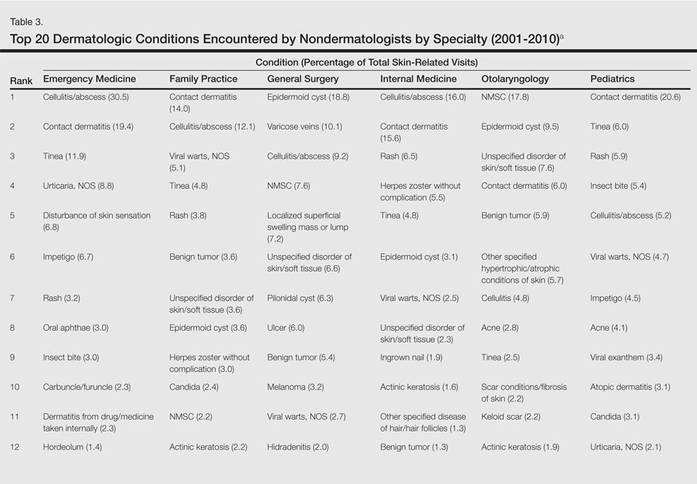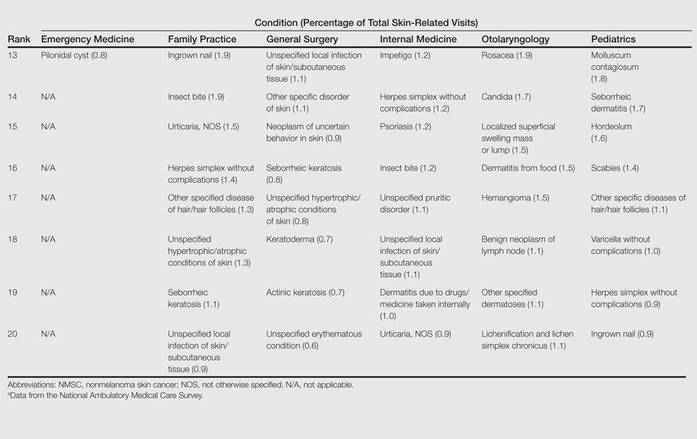Most Common Dermatologic Conditions Encountered by Dermatologists and Nondermatologists
The dermatologic conditions that are most commonly encountered by nondermatologists are not well characterized, which can hamper efforts to train them in skin disease management. The purpose of this study was to identify the 20 most common dermatologic conditions encountered by nondermatologic specialties (ie, emergency medicine, family practice, general surgery, internal medicine, otolaryngology, pediatrics). Data from the National Ambulatory Medical Care Survey from 2001 to 2010 were analyzed to evaluate the dermatologic diagnoses made by each specialty during this time period. The most common skin conditions reported by dermatologists were compared to those reported by nondermatologists. Nondermatologists evaluated 52.9% of cutaneous diseases that presented in the outpatient setting. Among each nondermatologic specialty included in the study, only 6 to 10 of the top 20 conditions overlapped with the top 20 conditions reported by dermatologists. This study is a retrospective review of a large database and only included skin conditions that were diagnosed in an outpatient setting. The skin conditions that most frequently presented to nondermatologists differed considerably from those most commonly seen by dermatologists. Because dermatologists often are responsible for training nondermatologists in the diagnosis and management of skin disease, curriculum content should reflect these differences to enhance the efficacy of such training opportunities.
Practice Points
- Approximately half of skin-related visits are to nondermatologists, such as family medicine physicians, pediatricians, and internists.
- Skin conditions that most frequently present to nondermatologists are different from those seen by dermatologists.
- Education efforts in nondermatology specialties should be targeted toward the common skin diseases that present to these specialties to maximize the yield of medical education and improve diagnostic accuracy and patient outcomes.
Results
From 2001 to 2010, more than 700 million outpatient visits for skin-related problems were identified, with 676.3 million visits to dermatologists, emergency medicine physicians, family practitioners, general surgeons, internists, otolaryngologists, and pediatricians. More than half (52.9%) of all skin-related visits were addressed by nondermatologists during this time. Among nondermatologists, family practitioners encountered the greatest number of skin diseases (20.5%), followed by pediatricians (11.3%), internists (9.2%), general surgeons (3.4%), otolaryngologists (1.0%), and emergency medicine physicians (0.2%)(Table 1).

Benign tumors and acne were the most common cutaneous conditions referred to dermatologists by nondermatologists (10.6% and 10.1% of all dermatology referrals, respectively), followed by nonmelanoma skin cancers (9.7%), contact dermatitis (8.8%), and actinic keratosis (7.8%)(Table 2). The top 20 conditions referred to dermatologists accounted for 83.7% of all outpatient referrals to dermatologists.
Among the diseases most frequently reported by nondermatologists, contact dermatitis was the most common (12.0%), with twice the number of visits to nondermatologists for contact dermatitis than to dermatologists (51.6 million vs 25.3 million). In terms of disease categories, infectious skin diseases (ie, bacterial [cellulitis/abscess], viral [warts, herpesvirus], fungal [tinea] and yeast [candida] etiologies) were the most common dermatologic conditions reported by nondermatologists (Table 2).

The top 20 dermatologic conditions reported by dermatologists accounted for 85.4% of all diagnoses made by dermatologists. Diseases that were among the top 20 conditions encountered by dermatologists but were not among the top 20 for nondermatologists included actinic keratosis, seborrheic keratosis, atopic dermatitis, psoriasis, alopecia, rosacea, dyschromia, seborrheic dermatitis, follicular disease, and neoplasm of uncertain behavior of skin. Additionally, 5 of the top 20 conditions encountered by dermatologists also were among the top 20 for only 1 individual nondermatologic specialty; these included atopic dermatitis (pediatrics), seborrheic dermatitis (pediatrics), psoriasis (internal medicine), rosacea (otolaryngology), and keratoderma (general surgery). Seborrheic dermatitis, psoriasis, and rosacea also were among the top 20 conditions most commonly referred to dermatologists for treatment by nondermatologists. Table 3 shows the top 20 dermatologic conditions encountered by nondermatologists by comparison.








